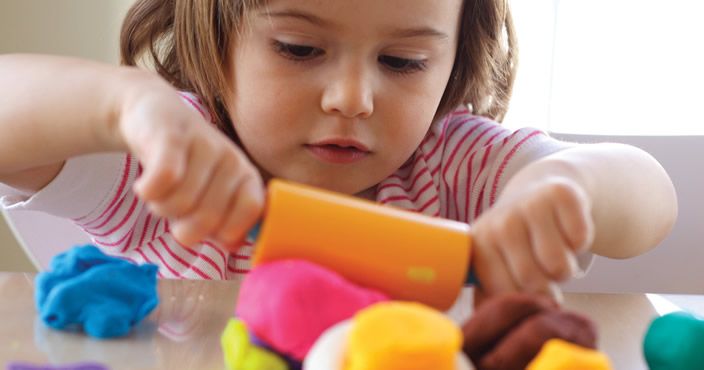
Teachers, academics and medical professionals have observed a significant change in the way young children are developing their fine motor skills with the rise in the use of tablets and iPhones, as Journalist Sara El Sayed writes.
Between the ages of three and five years, children typically begin to gain proficient control over their small muscle movements (fine motor skills), and start to master tasks such as doing up buttons and using scissors.
They also begin to refine their drawing and emerging writing skills: copying letters, numbers and shapes, as well as producing increasingly more complex drawings.
However, recent research shows that some children may be missing opportunities that help them to develop the skills needed to execute these functions.
Is mess best?
The benefits of the use of technology in the classroom are unquestionable; however, when messy play time is trumped by tablet use, young children’s fine motor skills are losing out.
Associate Professor Noella Mackenzie of Charles Sturt University said the issue extends outside the realm of technology versus handwriting, and also extends outside the classroom.
“It’s not about throwing out the tablet or stopping the use of technology – technology is part of today’s world – but we know that fine motor skill development is important for brain development, not just for handwriting but for many other skills that are associated with fine motor skills.
“Evidence of the loss of these skills is beginning to become apparent quite early in children’s lives.
“Ten years ago parents tended to give children pencils, crayons and paper to keep them busy.
“Unfortunately now it’s much easier to hand them the iPhone or the tablet.
“We see very young children who are being entertained in this way: a way that’s clean, efficient and easy.”
But this easy approach can come at a cost.
“Some children are not getting the opportunity to explore the manipulative processes that develop their fine motor skills.
“Activities such as playing with play-doh, drawing, cutting and pasting help develop these skills.
“Because these activities are often quite messy, a parent may be inclined to avoid them.
“But parents have to be prepared to deal with the messiness associated with a lot of the skills that develop fine motor in the early years before children start school,” Mackenzie said.
These activities are also integral to developing a child’s physical strength.
A child who comes to school who hasn’t had access to activities using scissors, cutting, pasting, drawing, and play-doh, lacks the fine motor skills as well as the strength in their hands, wrists and arms to hold a pencil for a length of time.
“A child who has had a lot of experience with drawing will often have developed their own efficient pencil grasp before they start school.
“Their teacher can then teach them to write letters needed for writing and reading.
“Children who don’t have these to skills are left to try to acquire them at the same time as learning to write and form letters, which can be very difficult,” Mackenzie said.
Not just fine motor skills at risk
Handwriting involves a lot of body skills that are not just fine motor related.
Posture, for example, and the core strength (including trunk, head and shoulder stability and balance) of the body helps a child sit in a way that allows them to write.
“If you’ve ever seen a child lie all over their desk, the chances are they haven’t got the core strength in their bodies to actually sit appropriately in order to use one hand for the pencil and the other hand to support the paper.
“There’s also a lot of research that identifies links between a child’s ability to write by hand and their ability to read and ability to spell, as well as other links to academic learning.
“This tells us that it’s far more than just the handwriting: it’s the development of those processes of manipulation and fine motor skill along with core strength.
“I come across a lot of people who say ‘but is handwriting important anymore?’ and the answer is yes, it is important.
“It’s not just important to develop the ability to write by hand, but also in improving all other skills that are associated with fine motor skill development,” Mackenzie said.
Addressing the issue with parents
Addressing the issue in a preschool context can make a world of difference.
Teachers and early childhood education staff provide these messy play opportunities to the children at their centres, with technology used to complement their pedagogical approaches.
But these skills need to be worked on outside the classroom as well as within it.
Mackenzie said if educators feel that there is a problem then it would be a case of talking to parents about the importance of fine motor skill development as a precursor to learning how to write, and suggesting that parents might engage in more activities at home.
“A common reaction from parents is that drawing and play-doh are messy, but when you explain to them how beneficial they are, parents are usually very supportive,” she said. “They want what is best for their children.”
Some suggestions to advise parents of include:
• play-doh, painting, finger painting and drawing with different implements
• block construction using salad tongs to pick up pieces (the fingers used to operate the tongs are the same used to hold a pencil)
• construction that requires manipulating small objects (eg Maccano, Duplo or Lego)
• building sandcastles
• building with cardboard boxes or toilet paper rolls using glue and sticky tape
• taking lids off jars and containers
• playing finger games (e.g. Incy Wincy Spider)
• puppet play
• card games
• lacing cards (children to use a shoelace poked through holes in card in sewing motion)
• threading beads, and
• string games (eg cat’s cradle).
For more information on activities that can help improve children’s motor skills, visit the Royal Children’s Hospital website www.rch.org.au/ot/information_sheets/Kids_health_information


































































































































